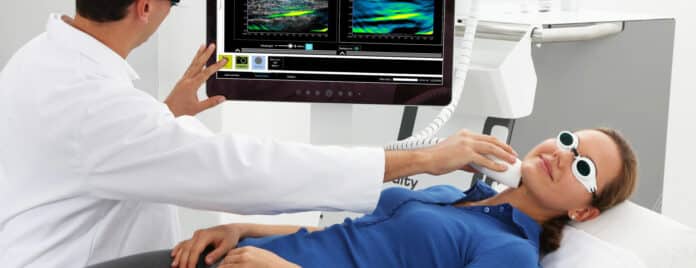Scientists and medical personnel frequently use imaging techniques like ultrasound and X-ray to comprehend and identify diseases. However, the quality and depth of the generated image vary depending on the tissue and need to be improved. Optoacoustic imaging is a new technique that combines the principles of ultrasound and laser-induced optical imaging. As a result, it is a potent medical imaging tool for non-invasively assessing a range of disorders.
A team of researchers from the Bioengineering Center, the Computational Health Center at Helmholtz Munich, and the Technical University of Munich have made significant progress in advancing high-resolution optoacoustic imaging for clinical use. They have developed a deep-learning framework known as DeepMB.
DeepMB allows clinicians to obtain high-quality optoacoustic images in real-time- about a thousand times faster than the state-of-the-art algorithm with virtually no loss in image quality. It holds great promise for patients with various illnesses, including breast cancer, Duchenne muscular dystrophy, and inflammatory bowel disease.
The optoacoustic imaging technique known as multispectral optoacoustic tomography (MSOT) is the subject of the study. The optoacoustic effect, where sound waves are produced when a substance absorbs light, is how an MSOT scanner operates. The instrument captures these sound waves and then converts them into images presented on the scanner monitor using reconstruction methods.
Unfortunately, the more complex algorithms that produce high-quality images take much longer than practicable in a clinical setting. In contrast, the simpler algorithms that can reconstruct images rapidly enough to display them in real time can only offer low-quality photos.
DeepMB reconstructs images about a thousand times faster with virtually no loss in image quality. The training method employed by DeepMB was the crucial innovation that unlocked this accomplishment. The training method used optoacoustic signals created from various real-world images and optoacoustic images created from matching signs. The resulting framework also resolves generalization, one of artificial intelligence‘s (AI) main difficulties. This means that regardless of the body portion being targeted or the ailment being studied, DeepMB can precisely reconstruct all scans taken from any patient.
Clinicians will finally have direct access to the best MSOT image quality, thanks to DeepMB. This is a significant advancement for this technology, favoring clinical trials and ultimately assisting in improving patient care. The fundamental ideas of DeepMB are also easily transferable to many other reconstruction techniques used in optoacoustic imaging, including other Helmholtz Munich research projects.
According to scientists, this framework can also be applied to imaging modalities such as ultrasound, X-ray, or magnetic resonance imaging (MRI).
Journal Reference:
- Christoph Dehner, Guillaume Zahnd, Vasilis Ntziachristos, and Dominik Jüstel (2023): A deep neural network for real-time optoacoustic image reconstruction with adjustable speed of sound. Nature Machine Intelligence. DOI: 10.1038/s42256-023-00724-3
